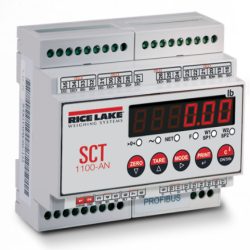What is a Weight Transmitter and what exactly does a Weight Transmitter do?
Weight transmitters or signal conditioning transmitters are specifically designed to be DIN rail mountable and seamlessly integrate weight data into PLC systems. Some of these transmitters are built with the ability to accept four independent scales or four load cell inputs. The often include (1) RS-485, (1) RS-232 communications, Analog Output 0 to 20mA, 4 to 20mA (Maximum 350 ohm) and 0 to 5VDC, 0 to 10VDC (Minimum 10,000 ohm)
What does a Weight Transmitter do in a PLC?
A weight transmitter can be the ideal solution for PLC systems which require weight data from a scale. These signal transmitters offer industry leading process control without the additional costs or shelf space of a standard digital weight indicator. These multi-function transmitters have a small design while offering the same signal-conditioning functions as many popular digital weight readouts.

Utilized as an independent or dependent four-channel digital junction box, the load cell transmitter allows for the direct reading and diagnosis of each individual connected load cell or summed as a whole. The ability to be DIN rail-mounted within a cabinet or control panel, permits a straightforward implementation into new and existing systems. Integration is also made simple with a wide range of available fieldbus communications, as well as optional Bluetooth® Wi-Fi and radio interfaces for external management.
What is a PLC?
A programmable logic controller (PLC) or programmable controller is basically an industrial computer for the control of a manufacturing process or device.
PLCs were first developed in the automobile manufacturing industry to provide flexible, rugged and easily programmable controllers to replace hard-wired relay logic systems. Since then, they have been widely adopted as high-reliability automation controllers suitable for harsh environments..
Weight Transmitter Cost Effective?
The weight transmitters can be a little less expensive than traditional advanced scale weight indicators. But the biggest advantage in most applications of the weight transmitter is its compact size and its affordable communication options.
How does a Standard Weight Indicator work for Scales?
A digital weight indicator is a weight display that communicates the weight of the items on the scale to an operator through a LED or LCD display. Weight data can then be viewed, and/or used to make a decision, and/or trigger an action as part of a larger process. Basic weight indicators simply display the weight, and might be able to do some basic batching applications and usually feature a serial output. More advanced scale controllers can include features such as analog output, USB ports, or ethernet ports. These devices are more advanced and can often control complex processes involving multiple data points that could require custom programming.
Connecting to Scales & Load Cells
Most tank scales or floor scales are built with a load cell or multiple load cells. They could be a compression load cell or tension load cells. The actual cells could be a shear beam load cell or S-Beam load cell. The load cell wiring is usually a standard color code that is easy to determine, depending on the load cell manufacturer. If more than one load cell is used in a scale, often a junction box with summing board will be used.
We offer a wide variety of weight transmitters from top scale manufacturers like Cardinal Scale Manufacturing and Rice Lake. Be sure to contact the sales department with your particular application requirements by clicking the RFQ button or by calling (919) 776-7737
